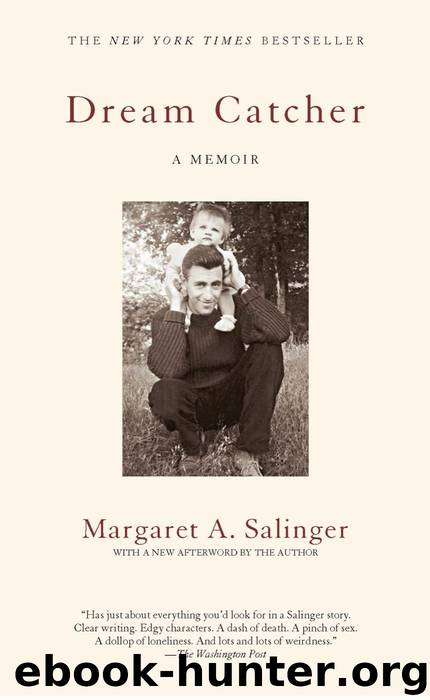Dream Catcher: A Memoir by Salinger Margaret A

Author:Salinger, Margaret A. [Salinger, Margaret A.]
Language: eng
Format: epub, mobi
Publisher: Washington Square Press
Published: 2013-09-10T00:00:00+00:00
* * *
1. My father wrote a story years ago called “Elaine” about a stunningly beautiful girl who is mildly retarded. Elaine is sixteen and in the eighth grade. She was, he wrote, the only girl wearing lipstick at her eighth-grade graduation except Theresa Torrini, the eighteen-year-old “mother of an illegitimate child by a taxi driver named Hugo Munster.” Elaine lives with her mother and grandmother in the Bronx. She is a lamb among wolves and is later raped by her first date, a movie usher. My father describes the three of them, mother, daughter, and grandmother, walking up the street together to the movies, Elaine “looking like centuries of Juliets and Ophelias and Helens. . . . There were thousands of Bronx people who saw them on their way. There was never one to cry out, to wonder, to intercept. . . .”
2. Seymour’s secret can be found in one of my favorite passages. It begins, “One late afternoon, at that faintly soupy quarter of an hour in New York when the street lights have just been turned on and the parking lights of cars are just getting turned on—some on, some still off—I was playing curb marbles with a boy named Ira Yankauer . . .” (Seymour: An Introduction, pp. 201–2).
3. Daddy later developed a way of purging himself of such delectable “poison.” He told me, quite proud of his newly discovered technique, that he’d stick his fingers down his throat and vomit it up. As one who struggled with bulimia for too many years, I find, in retrospect, his naivete less than appealing. Years later, he would teach Joyce Maynard this same technique of eliminating such impurities from her body.
4. From the Greek homoiopatheia, from homoiopathes, having like feelings or affections; homoios, like, similar, and pathos, feeling, suffering. The theory or system of curing diseases with very minute doses of medicine that in a healthy person and in large doses would produce a condition like that of the disease treated (Webster’s).
5. In the book Destructive Cult Conversion: Theory, Research and Treatment (American Family Foundation, 1981), Dr. John Clark of Harvard Medical School’s Department of Psychiatry writes: “In effect, the convert’s mind seems to split. A factitious second personality (the cult personality) begins episodically to achieve a certain autonomy as it struggles with the old one for position in the forefront of consciousness. The stress on the individual here is, of course, very great.”
6. Joyce Maynard writes in her memoir: “Jerry says nothing, ever, about me as a physical person. . . . No words are spoken about either of our physical bodies. . . . He virtually never mentions sex.” He does not mention, or perhaps notice at all, that Joyce, in her self-starvation, stops menstruating. In an article on “post–mind control” syndrome (Social Work, March 1982), Lorna Goldberg and William Goldberg, co-leaders of a therapeutic group for former members of religious cults, found that “almost all the ex-cultists appear to be much younger than their chronological age and display an asexual innocence.
Download
Dream Catcher: A Memoir by Salinger Margaret A.mobi
This site does not store any files on its server. We only index and link to content provided by other sites. Please contact the content providers to delete copyright contents if any and email us, we'll remove relevant links or contents immediately.
We're Going to Need More Wine by Gabrielle Union(18081)
Bombshells: Glamour Girls of a Lifetime by Sullivan Steve(13118)
Pimp by Iceberg Slim(12943)
The Radium Girls by Kate Moore(10914)
Becoming by Michelle Obama(9299)
The Girl Without a Voice by Casey Watson(7271)
Educated by Tara Westover(7074)
Wiseguy by Nicholas Pileggi(4598)
The Wind in My Hair by Masih Alinejad(4427)
Hitman by Howie Carr(4381)
On the Front Line with the Women Who Fight Back by Stacey Dooley(4317)
Hunger by Roxane Gay(4229)
Year of Yes by Shonda Rhimes(4121)
The Rules Do Not Apply by Ariel Levy(3913)
The Borden Murders by Sarah Miller(3593)
Papillon (English) by Henri Charrière(3278)
Joan of Arc by Mary Gordon(3267)
Patti Smith by Just Kids(3234)
How to be Champion: My Autobiography by Sarah Millican(3192)
